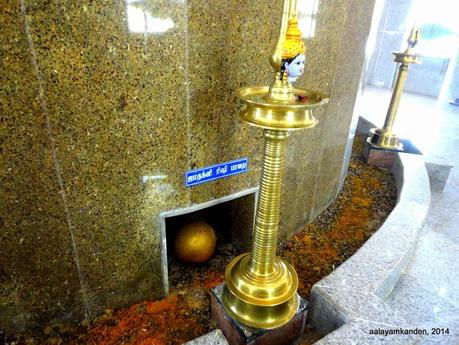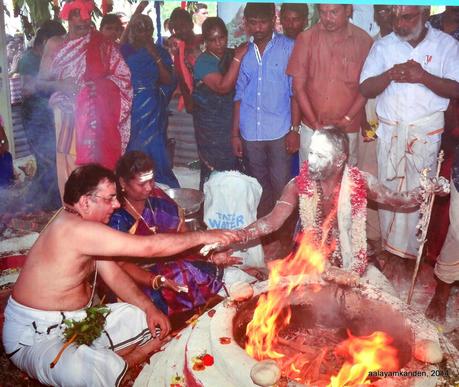
Construction being carried out at the Maha Bhairava Rudra Temple
A temple that has been built merely on instructions from Bhairava with no engineer or architect!The ten storey tall structure with the main and subshrines completed in five and a half months!
A temple where "Vaaiku Arisi" (rice provided to a person who has passed as part of the funeral rituals) is brought by the visitors to rid themselves of pain and suffering at death and to attain moksha!
A temple where visitors are not encouraged to bring and light lamps!
Surprised...read on to find out more about this temple!
On International Womens' Day, Doordarshan Podhigai had telecast an interview with me on the "Nam Virundhinar" programme. In this programme, I spoke about Aalayam Kanden, and its journey through ancient, unique and lesser-known temples of India. ( You can watch the program on Youtube here )
A couple of days later, I got a call from the Maha Bhairava Rudra temple, inviting me to visit the temple. I was unsure of how to respond, for Aalayam Kanden is primarily focused on ancient temples and what the trustee was describing was something very new. However, as he spoke further, I was very sure that the temple was indeed unique and lesser known. So off we set to visit the temple.
As we left the hi-tech buildings of Mahindra IT city behind, and turned into the mud road on the bank of a pond, it looked as if we had entered another world. The temple is located at the foothill of Thiruvadisoolam. Construction is ongoing in the sprawling complex. We are welcomed by the trustees and taken into the temple.

The twelve zodiac steps at the Maha Bhairava Rudra Temple
The circular sanctum sanctorum is in two levels. Twelve steps each representing a sign of the zodiac (the twelve Raasis) lead to the higher level where the main deity of the temple - Sri Kshetra Paala Bhairava stands in all his glory.
Sri Kshetra Pala Bhairava at the Maha Bhairava Rudra Temple
Enshrined in a transparent glass enclosure, with strands of Rudrakshas on either side of the opening, the Bhairava can be approached from the stairs behind. Shri Bhairava Siddhantham Swamy, the man behind the m ission of this temple says that the entire design of the temple was given to him by Bhairava.
Beneath the Bhairava, in the lower level are installed the Ashta Bhairavas, Saptha Rishis in the form of stones, and Saptha Kannis in the form of brass lamps.

Shrines for the Ashta Bhairavas at the Maha Bhairava Rudra Temple
There are a number of little blue and white lights in the ceiling that is shaped like a dome which give an ethereal atmosphere when switched on. Everything about the temple seems peculiar and unique. What is the significance of all this? I ask one of the trustees, Ms Selvi.

Saptharishis and Sapthakannis at the Maha Bhairava Rudra Temple
She explains that every single detail in the temple has been decided by Lord Bhairava himself and communicated through Bhairava Siddhantham Swamy, the man behind the whole mission. "You can ask him more when you meet him", she says.Originally from Nagercoil in Southern Tamil Nadu, he has been instructed by Bhairava to lead his mission and hence he has walked over twelve days, day and night, to reach this destined location where the temple was to be raised. The funds required to purchase the land had come in five days through the first believers in the mission who still stay with the Swamy as trustees of the temple. Once the land was acquired, the date for the Kumbabhishekam was fixed, and it was then that the construction was started. As planned, the entire shrine was complete in five and a half months.

With the trustees of the Maha Bhairava Rudra Temple
We leave the Sanctum Sanctorum to take a look at all the other shrines in the complex. " Bhagavan Paadham" is being constructed just outside the Main shrine for people to prostrate before." The Swamy does not allow anyone to fall at his feet," says Mr Vasudevan, one of the trustees , " No man should fall at another's is what he tells us", he continues.The Sthala Vriksham " Peepal Tree" grows on a pedastal and a trident has been installed before it. This is Bhairavi and it has been installed in the form of a trident, says Selvi. We then go around seeing the other dieties like Pancha Mukha Anjaneya which is still to be installed, Prathyankara Devi, Subramanya, Rudra Vinayaga, Vaishnavi Devi, Naga Rudra Eswara etc. We see a few dogs and ducks in front of the Vana Durgai Shrine, lazing under the trees. " Some people brought these dogs and ducks as gifts and we have been taking care of them since", says Selvi.

Vana Durgai at Sri Maha Bhairava Rudra Temple
As we go around the temple, we see a room with two large drums for raw and boiled rice. What are these drums for? Are they for feeding visitors to the temple? I ask. With a smile, the trustees explain that they are the drums containing the " Vaikku Arisi" brought by the visitors to the temple which is then used to feed the people. This is the primary offering that visitors are expected to bring when they come here, says Selvi. Perplexed, I ask her, " Vaikkarisi? You mean the last handful of rice that is placed on the mouth of a deceased person? Yes, she says, "you will hear more about it when you meet the Swamy".By now I am really curious to meet the Swamy who is attending to a group of children crowding around him in his residential quarters. It is a simple hut with basic amenities. We are ushered in and asked to wait for the Swamy to join us. A number of questions are running in our minds.

In conversation with Shri Bhairava Siddhantham Swamy
The Swamy is very unassuming and speaks as if he can read the questions in our mind. He starts explaining the significance of every single detail in the temple.The twelve steps in the main shrine: He says the steps represent the twelve signs of the zodiac and when one steps over them to reach the sanctum sanctorum all the doshas pertaining to the horoscope are cleared once and for all. A special " Padi Pooja" is performed on Chitra Pournami day which falls on the 14th of April this year.
Why are the steps behind Bhairava? In olden days, there were entrances on either side of the sanctum sanctorum so that visitors enter and exit the temple without showing their back to the deity.The construction of the stairs behind the deity ensure that visitors come around and pray and are able to descend without showing their backs to the diety.
Regarding the Vaikkarisi: The swamy explains that one cannot predict when and how their end would come and what kind of Bhairava Upadhai (suffering) will one have to undergo at that point.In order to avoid this, one must donate rice as Vaikkarisi during their life time. The rice so donated is used to feed the visitors to the temple. Visitors to the temple are expected to bring one handful of rice from every member of the family so rid themselves from any suffering during the last minutes of life.
No lights lit by devotees: A lamp that is lit must be protected till the oil is burned and then the flame must be extinguished with the help of a flower. If a lamp is lit, and is extinguished immediately because it was left uncared for, it is not appropriate. Hence the Swamy does not encourage lighting of lamps in the temple other than those that are cared for by the volunteers at the temple.
When will the ongoing construction be completed: He says it would take ten years for the entire construction to be completed, as per the instructions of Bhairava. As and when instructions are received to add new shrines the same is being undertaken.

During the Varushabhishekam of the Maha Bhairava Rudra Temple
Photo Courtesy: Maha Bhairava Rudra Temple
About his past life and current status: He says he had been called Subramania Pillai when he was at Nagercoil. When he became a messenger of Bhairava, people started calling him "Swamy". He says he is only human and not God and man becomes God only at the time of death. If a man's photograph moves from the drawing room to the pooja room, it means he has passed. When he gently forbade them from calling him Swamy he was not successful. Therefore, he started calling himself Bhairava Siddhantham Swamy. My mission is to pass on the message of Bhairava Siddhantham. Swamy is just a part of the name like Kandhaswamy, Munuswamy or Madaswamy, he says.
Bhairava Siddhantham: The Swamy has so far communicated over 6000 verses that have been revealed to him by Bhairava. Many of these verses have been placed in different parts of the temple.

On Temple Timings: Currently the temple is open between 6 am and 8 pm. Over time, the temple will be open 24*7 says the Swamy. He says it would take ten years for all the construction to be completed in the temple complex after which the temple will be open all through the day.
How to reach here:
Turn into Mahindra IT city on the outskirts of Chennai. Drive down till 8th Avenue. You will find Parker company on your left. Take a left turn and drive on till the road curves naturally to the right. You will find a board reading Kunnavakkam. Drive down the dirt track till you see the board of the temple. Turn left and the temple is about 200 metres from the main road.
There is a mini bus called Vishnu priya which plies frequently to the temple.
Contact Details:
Sri Maha Bhairavar Rudra Aalayam,
Sri Bhairavar Nagar,
Thiruvadisoolam Road,
Eechankaranai,
Chengalpattu - 603 003
Ph: 99403 92913, 94444 60759
